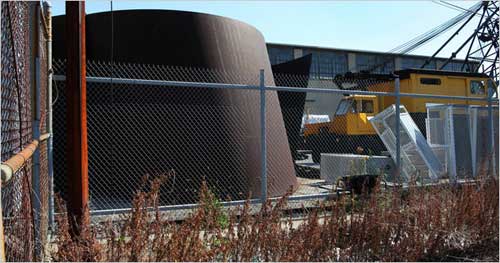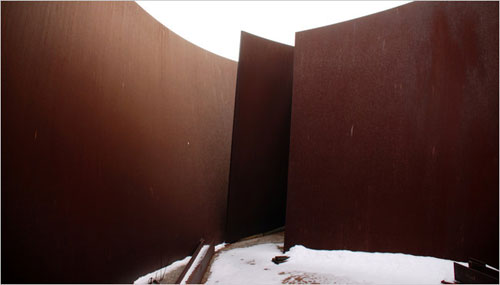
 Sculpture News at SculptSite.com
Sculpture News at SculptSite.com
Richard Serra Sculpture |
| The New York Times By SAM DOLNICK Richard Serra Sculpture Rusts in Bronx YardTO see gargantuan steel sculptures fashioned by Richard Serra, you could visit the Guggenheim in Bilbao, Spain, or the Dia: Beacon, 60 miles north of New York City. Or you could go to a crane yard near a heating-oil terminal in Port Morris, an industrial corner of the South Bronx. There, amid belching smokestacks and clanging delivery trucks, sits artwork made by Mr. Serra, a secret grace note in a decidedly ungraceful block. The briny air from the river just steps away blows across the steel plates, bent in a trademark Serra arc that would be recognized on the moon - which, in the art world, Port Morris might as well be. The piece - five plates, about one and a half stories high - is not displayed for public view or assembled as Mr. Serra intended. It stands behind a raggedy chain-link fence while a stray black-and-white cat stands watch. Cranes and falling-down sheds surround it. It has sat there for years, waiting to be delivered to its owner, said Joe Vilardi of Budco Enterprises, a Long Island rigging company that placed the steel in the Bronx lot and has long worked with Mr. Serra. "It is parts of a sculpture that are just in storage right now," Mr. Vilardi said. Mr. Serra, 70, is world-famous for his massive steel sculptures, which were the subject of a retrospective at the Museum of Modern Art in 2007. He is notorious for being particular about how his pieces are displayed. In the 1980s, Mr. Serra refused to move a sculpture that had been installed in Foley Square in Manhattan, declaring, "To remove the work is to destroy it." In a similar vein, his associates said the plates hiding in the crowded yard in the Bronx should not be considered a work of art at all, and certainly not a bona fide Serra sculpture. In their eyes, a Serra is not a Serra until Mr. Serra says it is; this, they say, is a big hunk of metal behind a chain-link fence. "To him it really isn't his work unless it's installed properly," said Trina McKeever, Mr. Serra's studio assistant. She asked that the exact location of the Bronx piece not be revealed, to prevent graffiti and vandalism. If it is just a parked piece of steel, it is surely the most valuable heavy metal in a neighborhood filled with the stuff. In May, Sotheby's sold a much smaller Serra sculpture for $1.9 million. The Gagosian Gallery, which represents Mr. Serra, would not reveal the owner or the price of the piece in the Bronx. Whether art or art-to-be, it is striking just the same. Seen from the lot next door, it is a rusty mirage, an amber curve that overshadows a nearby crane truck and stands next to a corrugated tin shed of similar size if not sensuality. When the sun hits the delicate outer slope, it shimmers. In place of the usual curatorial card that might provide some insight as to the material or inspiration behind the work, there is a sign saying, "No Trespassing, No Dumping." Told of the unlikely exhibition, Eric Stark, curator of the New School Art Collection, made the pilgrimage one recent morning to see for himself. "Wow," he said, walking up to the fence. "If you've seen enough of these ellipses, it just screams out that this is a Richard Serra." Nearby, a shopping cart lay in the shrubs. Used condoms and decomposing cardboard littered the ground. "I find the whole thing incredibly poetic," Mr. Stark said. "There is something gritty and real about it, to the sculpture and the neighborhood." Art storage is big business in New York, and there are expansive spaces in places like the Brooklyn Navy Yard. But the art is generally stored inside - not in a lot where cranes are parked. The would-be sculpture sat nestled into a corner of the property, not far from a huge structure missing several window panes. The signature rust on Mr. Serra's work, a rich maroon that almost glows, matched the color of the dilapidated structure. Yet the two rusts were not the same - one was destined for art history books and learned dissertations. The other was destined for the scrap heap. Bloggers and intrepid photographers have discovered the Serra piece in the unlikely storage spot and published the results of their explorations online. In 2006, artists sneaked into the site and covered the piece with magnets as part of a project titled "Invisible Graffiti." Nathan Kensinger, a photographer, stumbled upon the Serra piece in February 2009 and managed to walk among its spirals. "I've come across a lot of surprising, abandoned things in New York City, but never before a Richard Serra piece that's worth millions of dollars," he said in an interview. One of Mr. Kensinger's pictures, which he displayed on his blog, shows the word "Bellamy" scrawled across a beam. A Serra sculpture called "Bellamy," named for Richard Bellamy, one of his early dealers, was shown at a Gagosian space in Chelsea in 2001. Mr. Serra's studio declined to comment on whether the Bronx work was the Bellamy sculpture. In some respects, Mr. Serra's steel plates blended nicely into the industrial surroundings, which made them look far less monumental than, say, the pieces in the MoMA retrospective. Unassembled, they may not even be the most striking sight on the Port Morris coast. Nearby stand two rusting gantries, five-story arches that were used as ferry slips in the 1950s and abandoned decades ago. This decaying Stonehenge stands as a memorial to the lost New York of stevedores and railyards. "If you put that sculpture next to these gantries, people would come from all over the world to see it," Mr. Stark said of the Serra curves. "There's a lot to be said of coming upon art in unusual places outside of the museum." Mr. Serra has long had a fascination with America's industrial history. When he was 18, he worked on a rivet gang with U.S. Steel before enrolling at Yale University. Many of his sculptures are made of Cor-Ten steel. "I'm sure he would rather pass the day talking to a steelworker than an art historian," Mr. Stark said. Harry Bubbins, an environmentalist who has fought to improve waterfront access in the South Bronx, is one of the few who knows about the Port Morris "installation." He is not impressed - "To me, it's just an object on the shoreline blocking access like anything else" - but he knows that others would be. He and the local advocacy group Friends of Brook Park seek to create a sculpture garden at the gantry site that would be modeled on the Socrates Sculpture Park in Long Island City, Queens. The centerpiece, Mr. Bubbins dreams, could be the Serra sculpture. It would certainly reduce shipping costs. |
 Thank you to Sam Dolnick for a most interesting read. Evidently Paul Harvey wouldn't be able to tell us the 'rest of the story', so to speak. Seems everyone is a bit tight-lipped, and that's OK. Moving on - Richard Serra is a master at what he does. Now if the group 'Friends of Brook Park' can pull their ideas and dreams together, it could be a win-win situation for all. Go Mr. Bubbins and the Friends of Brook Park! |
 A massive sculpture by Richard Serra stands in a fenced lot in the South Bronx. Richard Perry/The New York Times |
 |
More Sculpture News ....
Submit your SCULPTURE NEWS.
It's easy, just send us an e-mail
(click on Submit News in the left menu) with your pertinent information along with images, we'll take care of the rest. Sculpture makes our world a much better place in so many ways!
SculptSite.com, along with Sculptors and their creative genius all helping to bring the beauty and message of Sculpture to a hurried world.

